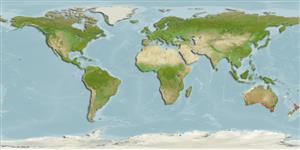>
Gobiiformes (Gobies) >
Gobiidae (Gobies) > Gobiinae
Etymology: Callogobius: Greek, kalos, kallos = beautiful + Latin, gobius = gudgeon (Ref. 45335).
More on authors: Ramsay & Ogilby.
Environment: milieu / climate zone / depth range / distribution range
นิเวศวิทยา
เกี่ยวกับทะเล,น้ำเค็ม; กร่อย เกี่ยวกับหินโสโครก. Temperate
Indo-West Pacific: Widespread in southern Australia, from New South Wales to South Australia, including Tasmania.
ขนาด / น้ำหนัก / Age
Maturity: Lm ? range ? - ? cm
Max length : 14.0 cm TL เพศผู้/กระเทย; (Ref. 9002)
Found in shallow rocky reefs, including estuaries (Ref. 9002). Very secretive, under rocks or in narrow ledges (Ref. 9002).
Life cycle and mating behavior
Maturities | การสืบพันธุ์ | Spawnings | Egg(s) | Fecundities | ตัวอ่อน
Kuiter, R.H., 1993. Coastal fishes of south-eastern Australia. University of Hawaii Press. Honolulu, Hawaii. 437 p. (Ref. 9002)
IUCN Red List Status (Ref. 130435)
Threat to humans
Harmless
Human uses
เครื่องมือ
Special reports
Download XML
แหล่งที่มาจากอินเตอร์เน็ต
Estimates based on models
Preferred temperature (Ref.
123201): 13.7 - 23.3, mean 17.6 °C (based on 369 cells).
Phylogenetic diversity index (Ref.
82804): PD
50 = 0.5000 [Uniqueness, from 0.5 = low to 2.0 = high].
Bayesian length-weight: a=0.00912 (0.00295 - 0.02818), b=2.98 (2.72 - 3.24), in cm total length, based on LWR estimates for this (Sub)family-body shape (Ref.
93245).
ระดับชั้นอาหาร (Ref.
69278): 3.4 ±0.4 se; based on size and trophs of closest relatives
ความสามารถในการกลับคืนสู่ปกติ (Ref.
120179): ความสูง, เวลาต่ำสุดที่จะทำให้ประชากรเพิ่มขึ้นเป็น 2 เท่าใช้เวลาน้อยกว่า 15 เดือน (Preliminary K or Fecundity.).
Fishing Vulnerability (Ref.
59153): Low vulnerability (10 of 100).
Nutrients (Ref.
124155): Calcium = 38.4 [12.7, 81.4] mg/100g; Iron = 0.237 [0.098, 0.515] mg/100g; Protein = 18.5 [16.5, 20.3] %; Omega3 = 0.234 [0.095, 0.537] g/100g; Selenium = 5.01 [1.70, 15.43] μg/100g; VitaminA = 72.8 [14.5, 352.3] μg/100g; Zinc = 1.05 [0.61, 1.78] mg/100g (wet weight);
